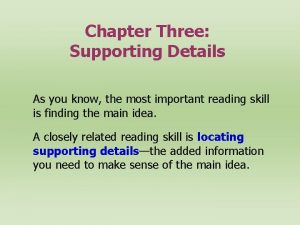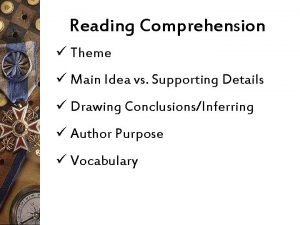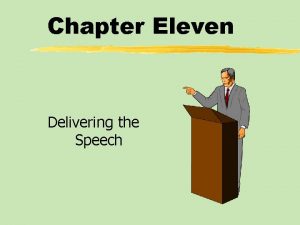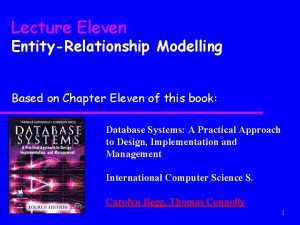Chapter Eleven Main Points Supporting Points and Transitions
















- Slides: 16

Chapter Eleven Main Points, Supporting Points, and Transitions

Chapter Eleven Table of Contents z. Main Points: Making the Claim z. Supporting Points: Supplying the Evidence z. Principles of Organizing Main and Supporting Points z. Transitions: Giving Direction to the Speech

Main Points, Supporting Points, and Transitions Speech structure: y. Introduction establishes the purpose and relevance y. Body presents main points y. Conclusion ties the purpose and main points together.

Main Points: Making the Claim z. Main Points: used to express the key ideas and major themes z. Also used to make claims in support of thesis

Main Points: Making the Claim z. Using the Purpose and Thesis Statements as Guideposts z. Number of Main Points z. Form of Main Points

Main Points: Making the Claim: Using the Purpose and Thesis Statements as Guideposts The specific purpose and thesis statements can be guideposts to help generate the main points of your speech.

Main Points: Making the Claim: Number of Main Points Use two to seven main points, depending on • Topic • Amount of material • Length of the speech

Main Points: Making the Claim: Form of Main Points A main point should only introduce one idea.

Main Points: Making the Claim: Form of Main Points z. Parallel Form: stating main points in similar grammatical form and style

Supporting Points: Supplying the Evidence z. Supporting Points: material or evidence gathered to justify the main points z. Main points are enumerated with uppercase Roman numerals z. Supporting points with capital letters

Principles of Organizing Main and Supporting Points z. A well-organized speech is characterized by unity, coherence, and balance.

Principles of Organizing Main and Supporting Points: Unity y. Unity: when a speech contains only points related to the purpose and thesis statement.

Principles of Organizing Main and Supporting Points: Coherence z. Coherence: clarity and logical consistency throughout z. Subordination and coordination: logical placement of ideas relative to their importance to one another

Principles of Organizing Main and Supporting Points: Balance z. Balance: an appropriate amount of weight given to each part of the speech relative to the other parts

Transitions: Giving Direction to the Speech z. Transitions: words, phrases, or sentences that tie the speech ideas together zrhetorical question zrestatement of the previous point zforecast of the next point

Transitions: Giving Direction to the Speech z. Internal preview: a transition that tells the audience what to expect next. z. Internal summary: draws together important ideas before proceeding to the next point.
 Supporting points
Supporting points Topic sentence about train system
Topic sentence about train system What is implied main idea
What is implied main idea Minor supporting detail?
Minor supporting detail? Main idea and supporting details example paragraphs
Main idea and supporting details example paragraphs Main idea jeopardy
Main idea jeopardy Main idea and supporting details examples
Main idea and supporting details examples Topic, main idea and supporting details examples
Topic, main idea and supporting details examples Major detail
Major detail Outline supporting details
Outline supporting details Reading comprehension main idea and supporting details
Reading comprehension main idea and supporting details Whats a supporting idea
Whats a supporting idea Example of main idea and supporting details
Example of main idea and supporting details Example of topic sentence in paragraph
Example of topic sentence in paragraph Three supporting details
Three supporting details Making an outline
Making an outline Main idea and supporting details
Main idea and supporting details































